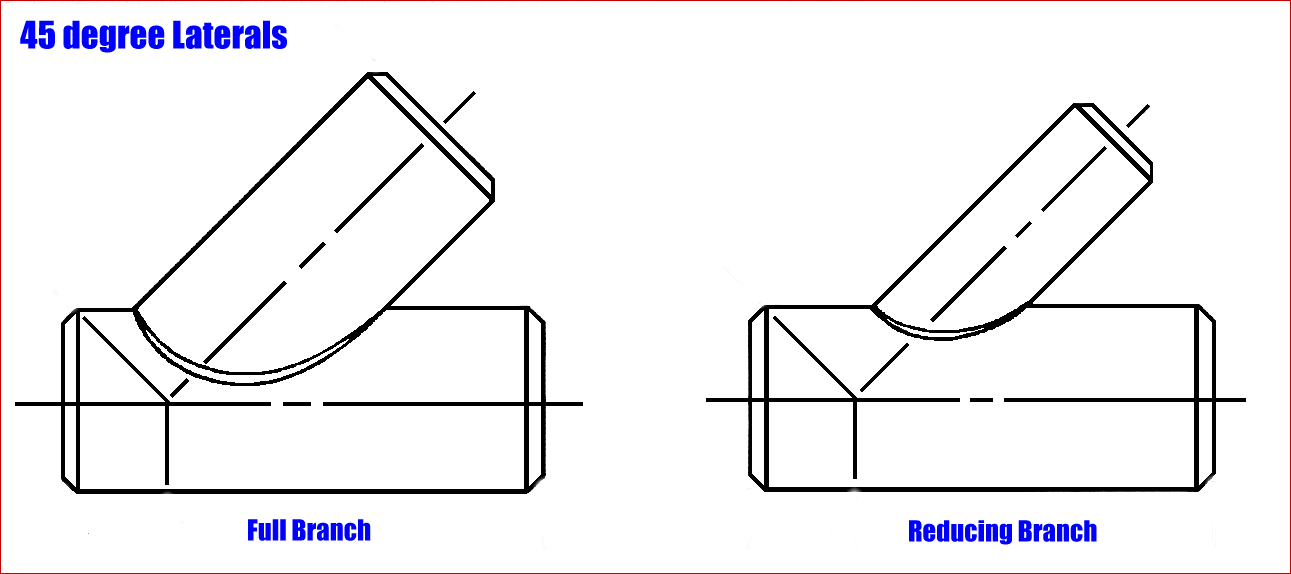Software Solutions
- CAEPIPE 3D+
- dataTRANSLATORS
- checkSTRESS
- HOTclash
- PEXit
- Pricing Request
- Download CAEPIPE 3D+
- Download Free Evaluation
- Download Free Review Module
- Customer Support
Engineering Services
- Design and Engineering
- INFOplant™ System
- Engineering Management
- List of Projects
- Project Gallery
- Project Videos
Learn More
Company Information
Tips April - June 2006
45° Laterals
User Question: How does one account for these lateral connections?
Reply: I would use the SIF for an unreinforced fabricated tee and evaluate the branch stress using the section modulus of the branch. The connection footprint on the run pipe itself has a section modulus greater than the branch section modulus and this will compensate for the unreinforced fabricated tee SIF which should be lower than the unreinforced fabricated lateral SIF. I'd ignore the fact that a reduced outlet branch connection requires an "effective section modulus" in accordance with B31.1 Para. 104.8.4(C) or B31.3 Para. 319.4.4(c) and just calculate the intensified stress as the unreinforced fabricated tee SIF x the branch moment / branch section modulus (whether you use the SIF times the resultant moment approach of B31.1 or the in-plane and out-plane SIFs times the in-plane and out-plane moments, respectively, approach of B31.3 I'd use the same philosphy of ignoring the "effective modulus."

Pay particular attention to the fabrication of the lateral making sure that the Code required cover fillet dimensioned t(c) in B31.1 Fig. 127.4.8(D)(a) or B31.3 Fig. 328.5.4D(1) meets the required size. If the cover fillet is larger than t(c) that improves the lateral SIF. The figures and dimensions shown (not shown here, please contact us if you want to get a copy of them) are a bit unfortunate, especially for a lateral because a strict reading of the Code would seem to require a bigger weld on the obtuse side of the branch and a smaller weld on the acute side of the branch when just the opposite is true. Having a constant cover fillet weld leg length all around the branch would improve the requirement and we've been working on that. Personally, I think the larger the run and branch pipes are the larger the cover fillet should be. Ask for or calculate whether area replacement requirements B31.1 Para. 104.3.1(D) or B31.3 Para. 304.3.3 are met noticing that the required reinforcement for a lateral is greater by the factor (2 - sin alpha).
Author: Mr. Ron Haupt, P. E., of Pressure Piping Engineering (www.ppea.net) is a member of several piping code committees (B31, B31.1, B31.3, BPTCS, and others). He consults with us in the capacity of Nuclear QA Manager.
How to Compute Minimum Pipe Wall Thickness Using CAEPIPE
Using most B31 and international piping codes, you can calculate the minimum pipe wall thickness (tm) required for a piping system once you know the following pieces of data:
1. P = Internal design pressure
2. D = Outside dia. of pipe
3. S*E = Maximum allowable stress at design temperature * material joint factor
4. Y = Pressure coefficient from the piping code (usually 0.4)
5. A = Additional thickness to allow for threading corrosion
Most code equations are similar to the following:
tm = [(P*D) / 2 (Y*P + S*E)] + A, see equation 4 from B31.1, paragraph 104.1.2.
Model a few pipe elements after you put in materials, sections and loads into CAEPIPE. Analyze. Look at Code Compliance. The second column reports "Press Allow (psi)." "Press" stands for internal design pressure (P) you input. "Allow" stands for allowable pressure computed according to the equation above. The internal design pressure needs to be less than the allowable pressure. If not, then increase the wall thickness of the section and recalculate the pressure until you arrive at an appropriate wall thickness. If necessary, you might want to decrease the wall thickness too. Each change in the wall thickness will affect the stresses (SL, SE) and subsequently the stress ratios. A thicker wall increases the stiffness of the system.
For the sample model we provide with every copy of CAEPIPE (free and licensed), notice below how the allowable pressure changes with the wall thickness for an 8" pipe. (Internal Design Pressure, P = 200 psi)
| Schedule | Thickness (in.) | Allow. Pressure (psi) |
|---|---|---|
| 80 | 0.5 | 2103 |
| 40 | 0.332 | 1332 |
| 20 | 0.25 | 1027 |
| 5S | 0.109 | 442 |
Note: To account for A, you need to add it to the corrosion allowance field for Section in CAEPIPE.
You can arrive at an optimum wall thickness after just a few iterations.
Comments on Butt Welds
Please visit our Pipe Stress Article page this topic at the following link Comments on Butt Welds

